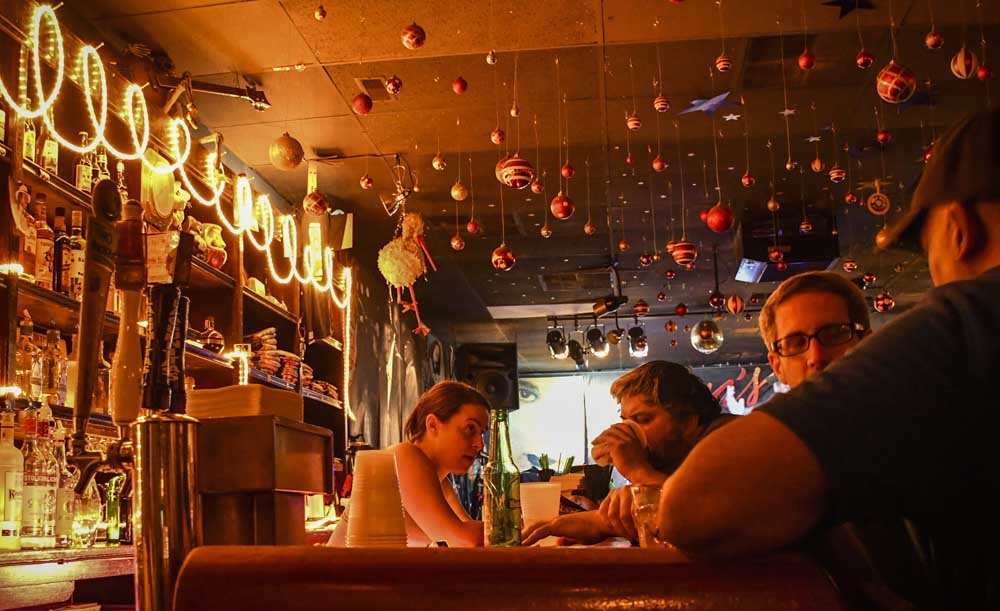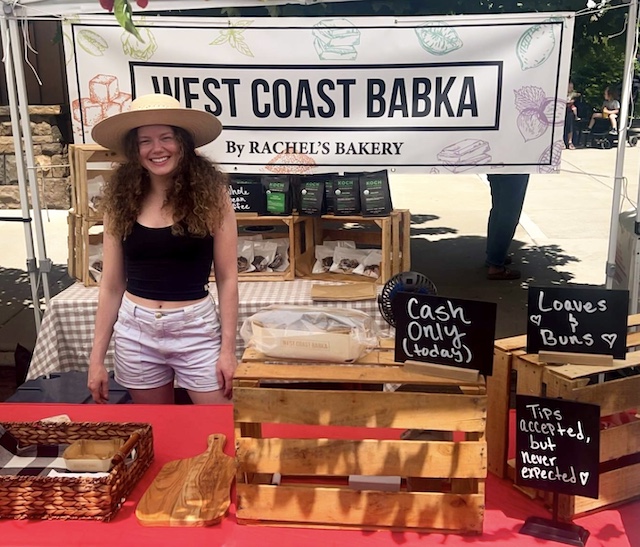Chasing those Chicago blues
Published 12:00 am Sunday, September 9, 2018

- Rosa’s Lounge is a longtime blues club in the Logan Square neighborhood of Chicago.
CHICAGO — “Dancing Aloud,” a sign said. On stage, guitarist Corey Dennison, 43, white and well tattooed, had just opened an instrumental conversation with a grandfatherly figure in a White Sox cap.
“This is my old man, Mr. Carl Weathersby,” Dennison told the crowd. “He taught me everything I know about the blues.”
Weathersby, 65, and African-American, nodded. The notes rose, fell and tangled like family voices around a dinner table. The players, related only by a passion for music, grinned and winced the way soloists do.
In the audience, 100 blues lovers roared, clapped, drank and chattered in three or four languages.
This was Kingston Mines, the oldest, biggest club of its kind in Chicago, on a recent Monday night. Like the rest of the international audience, I was here to listen to an embattled American sound — Chicago-style electric blues, born in the mid-20th century as African-American families moved north from the Mississippi Delta.
In that migration, legions of country blues musicians traded their acoustic guitars for electrics, started playing their harmonicas through microphones and launched an era of rough-edged, streetwise music, sibling to soul, cousin to gospel.
The sound filled mostly black clubs on Chicago’s South and West sides. New arrivals played for tips on Maxwell Street, and the biggest names released albums on Chess Records and blazed a musical path that rock ‘n’ roll soon would follow.
But Chicago and pop culture have moved on.
Though the vast, free Chicago Blues Festival takes over Millennium Park every June, and the locally headquartered Delmark and Alligator labels release new blues and roots tunes, rap music dominates the South and West sides.
You must go to the Loop and north, where the tourists are, to find the remaining handful of all-blues clubs.
I wanted to see and hear them before things changed any more, so I spent three days and nights this summer chasing Chicago blues through five clubs, one museum exhibition and one storied old studio.
‘It’s just real’
Kingston Mines, born in the late 1960s and a fixture on Halsted Street in Lincoln Park since 1982, was my first stop.
Although the surrounding neighborhood is collegiate, urban and prosperous, the club aims for a rural juke-joint feel, with fried okra and catfish fingers on the menu, a map of “blues country” on the wall and tangles of Christmas lights here and there. It’s too big to be called intimate, too gritty to be mistaken for a House of Blues.
It features two stages (so two bands can alternate sets without long delays in between) and a kitchen (Doc’s Rib Joint). The live music plays until about 3:45 a.m. every night except Saturday into Sunday, when it lasts an hour longer.
“There’s pretty much no place I know like this on the planet,” said Joanna Connor, a singer and guitarist who has played at the club for more than 30 years.
“It’s just real, man. It’s real people,” Dennison told me.
Dr. Lenin Pellegrino, a general practitioner and social crusader, owned the club for decades, relying on an audience that’s a mix of locals, tourists and students from nearby DePaul University.
“Doc” Pellegrino died in May at 92. His grown children run the club.
“It’s an integrating force,” manager Lisa Pellegrino told me. “We have people sitting here who, back home, their countries are at war.”
As I chatted with the musicians between sets, I learned how Weathersby broke in as a guitarist for bluesmen Albert King and Billy Branch, started his own group, then hired Dennison and mentored him for years.
Dennison and his band play two nights a week at Kingston Mines. Weathersby, who has moved out of state, had dropped by to listen.
As in all the clubs I checked out, the monthly schedule showed a mix of black and white performers, mostly homegrown. The audiences were probably less than 10 percent black and included a lot of blues-hungry visitors from Europe and Asia.
More than once, I thought of a question Chicago Tribune music critic Howard Reich posed in 2011: “How long can a black musical art form remain dynamic when presented to a largely white audience in settings designed to replicate and merchandise the real thing?”
I have no answer. But the music, done right, still thrills. Stories of loss and longing. Bursts of wild exhilaration. Moments of understanding that reach beyond age and race.
“It’s electric folk music,” Bruce Iglauer, the Chicago-based founder of Alligator Records, told me. “And folk music changes as the folks change.”
Whatever the future, there is plenty of blues culture to see and hear this year in the city.
At the Chicago History Museum, I browsed through the “Amplified: Chicago Blues” exhibition (through Aug. 10, 2019), which includes vintage photos of wild nights in long-gone South Side clubs; hands-on features inviting you to sing or play guitar (with the amp’s distortion level set to good ‘n’ crunchy); and an introduction to the region’s key players.
From Mississippi came Muddy Waters to sing “Mannish Boy,” Howlin’ Wolf to sing “Smokestack Lightnin’,” Bo Diddley to lay down the five-beat syncopated rhythm that drives “Who Do You Love?” Willie Dixon to write “Hoochie Coochie Man” and shape the Chicago blues scene for years as a bassist and producer.
From Tennessee came Koko Taylor to sing “Wang Dang Doodle.” From Louisiana came harmonica player Little Walter and guitarist Buddy Guy, 82 and still performing at his club, Buddy Guy’s Legends.
A heaping of history
My other daytime stop was Willie Dixon’s Blues Heaven Foundation, a surprisingly compact building that housed Chess Records from the mid-1950s to the mid-1960s. There, tour guide Janine Judge led me upstairs to the studio where Waters, Diddley, Taylor and Dixon did some of their best work.
This was also where Chuck Berry recorded “Johnny B. Goode” in 1958 and Etta James recorded “At Last” in 1960; where the Rolling Stones recorded a smoldering instrumental track titled “2120 South Michigan Avenue” in 1964 while on their first U.S. tour.
Judge, carrying a portable speaker, cranked up the volume on classic songs and pointed out the late Dixon’s old bass in one corner.
She explained how brothers Leonard and Phil Chess built the label and how Dixon sued Led Zeppelin decades ago, accusing the band of using his words and music in the songs “Bring It on Home” and “Whole Lotta Love.” This led to settlement payments, amount undisclosed.
Without that cash, who knows whether this building would still be standing?
By night, I club-hopped, paying cover charges of $5 to $12.
At Rosa’s Lounge, the scene is intimate, and the hospitality has a homespun Italian inflection. Italian immigrant (and drummer) Tony Mangiullo opened the place in 1984, and it’s been a fixture in the Logan Square neighborhood.
I showed up on a slow weekday night — fewer than 10 customers were inside and nobody on the street outside. On stage, Nigel Mack, a singer and multi-instrumentalist, was working without his usual guitarist. That meant we didn’t get the harmonica heroics Mack is known for, but I was happy to sit up close and admire his slide guitar work.
The city’s blues scene “goes up, and it goes down,” Mack told me during a break. “But the state of the blues has got to be healthier here than it is anywhere else in the world.”
At Buddy Guy’s Legends, a posh place next to the Hilton in the South Loop, I caught Mz Peachez and Her Casanovas.
If I were smarter, I’d have arrived early enough to order dinner — those who reserve ahead and sit to eat get the best spots. While I stood in back, Mz Peachez assessed her crowd and veered from standard blues titles to disco favorites “Bad Girls” and “I Will Survive.”
On my last night in town, I circled back to Kingston Mines, where Dennison again was prowling the stage, singing Willie Nelson’s lyrics about how “the nightlife ain’t no good life, but it’s my life.”
Weathersby was in the audience again.
“The things that blues are about — they aren’t going away as long as there’s people,” he told me. With players such as Dennison on the scene, Weathersby added, “It’s in good hands for another 20 years.”






